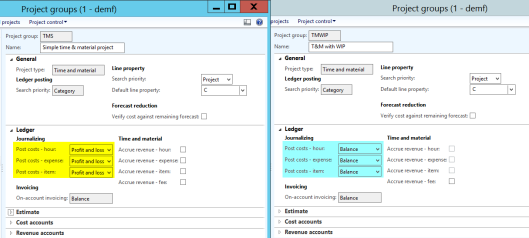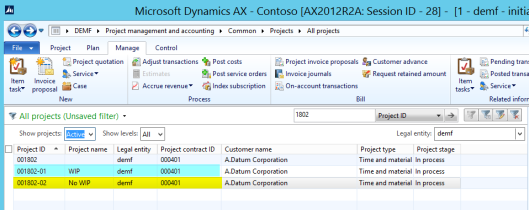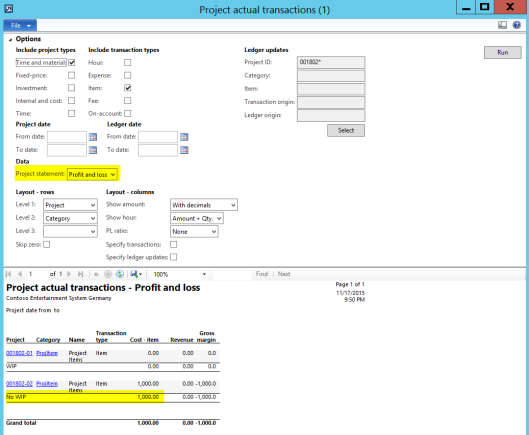
|
|
#1 |
|
Участник
|
dynamicsax-fico: Challenges for trading companies using the project module
Источник: http://dynamicsax-fico.com/2016/03/0...roject-module/
============== Using the project management and accounting module in companies that are not primarily operating in the business project area but rather in trade or manufacturing can be beneficial due to the numerous additional analysis options available in the project module. Those advantages do however come at a price especially in regards to a more complex inventory valuation. Within the following, I will illustrate you those difficulties and provide you some hints on how to overcome them. The starting point for the next illustrations are time and material (T&M) projects that have been setup with profit and loss (P&L) and balance sheet (BS) posting project groups in order to show you the difference in the usage of the one and the other project group.  Note: For reasons of simplicity the project with the BS posting is referred to as “WIP” project while the project with the P&L posting is referred to as “ordinary” or “non-WIP” project. From a financial accounting perspective, the following ledger accounts have been setup.  Note: All ledger accounts setup for the “WIP” posting types are Balance Sheet accounts and all ledger accounts setup for the “Cost” posting types are Profit & Loss ledger accounts. With this setup in place, I created the following two T&M projects that are used for recording an ordinary process cycle of a trading company that starts with the creation of the purchase order and ends with invoicing the customer. This process cycle will be illustrated step-by-step in the subsequent sections.  Step 1: Create Purchase Order At the time the purchase order is created, Dynamics AX does not create any inventory / ledger transaction. Yet, depending on the setup of the project module, a so-called item requirement is created that allows you identifying and estimating the forthcoming costs. Step 2: Post product receipt The next step in my process cycle is recording the product receipt for the items ordered (100 pcs * 10 EUR/pcs). For the WIP project, Dynamics AX generates the following two vouchers:
 Note: The first item (“L13100”) was used for the WIP project while the second item (“L13200”) was used for the ordinary T&M project. What you can identify from the physical inventory section of the inventory value report (highlighted in red color) is the purchase order packing slip transaction that increases inventory. At the same time, AX created a financial inventory transaction that reduced inventory by the very same amount resulting in an overall inventory quantity and amount of 0. In other words, even though the items have not been sold / invoiced to the customer, you cannot identify them in your inventory anymore as they are already consumed for your project. Step 3: Post purchase order invoice The next step in my process cycle is posting the purchase order invoice. This posting generates the following voucher for the WIP and the ordinary T&M project:  After the purchase order is invoiced, the inventory value report shows the following outcome:  As you can identify from the screen-print above there is no inventory left despite the fact that the items have not been shipped / invoiced to the customer. If the items have not been shipped and invoiced to your customer the question arises how you could identify and report on your inventory? One possibility to do that is by referring to the project WIP report that is shown in the next screenshot.  What you can identify from this report is that it works only for the WIP project but not for the ordinary project with P&L posting. An alternative is the project actual transaction report that allows you flipping between the different project types by changing the project statement focus.  Yet, in both cases you only get financial amounts but no quantities. Let’s continue by having a look at what happens if you invoice your customer a part of the items purchased. Step 4: Invoice customer for a bundle of 30 pcs After the purchase order invoice has been recorded, the customer is invoiced for a part (30 pcs * 100 EUR) of the goods via an ordinary project invoice. This generates the following voucher for the WIP project:  The invoice for the ordinary project results in the following voucher:  Given those invoices 70 pcs of the item with a total inventory value of 700 EUR remains. The previously used project WIP report shows this amount for the WIP project but not for the ordinary T&M project.  Unfortunately, the second alternative report used before – the project actual transaction report – is not able to show you the inventory value, neither for the WIP, nor for the ordinary project and thus leaves you with the requirement of setting up a specific project related inventory value report.  Summary: Overall it can be summarized that the use of the Dynamics AX project module can have several advantages for companies not primarily operating in the business project area. Yet, you have to be aware that recording ordinary purchase and sales orders through this module can cause issues when it comes to inventory valuation especially in situations where products are not purchased and sold within the same accounting period. From this perspective, the use of projects with WIP (Balance Sheet postings) seem to be better suited. Notwithstanding this preference of the author, it seems very likely that your auditors will ask for a specialized inventory value report that you need to create yourself to fulfil reporting / auditing requirements. This (cost) disadvantage needs to be weighed against the potential advantages that the project module offers for trading companies. Filed under: Project Tagged: Inventory valuation, Project module, Purchase Order, Sales order Источник: http://dynamicsax-fico.com/2016/03/0...roject-module/
__________________
Расскажите о новых и интересных блогах по Microsoft Dynamics, напишите личное сообщение администратору. |
|
|
|
|
|